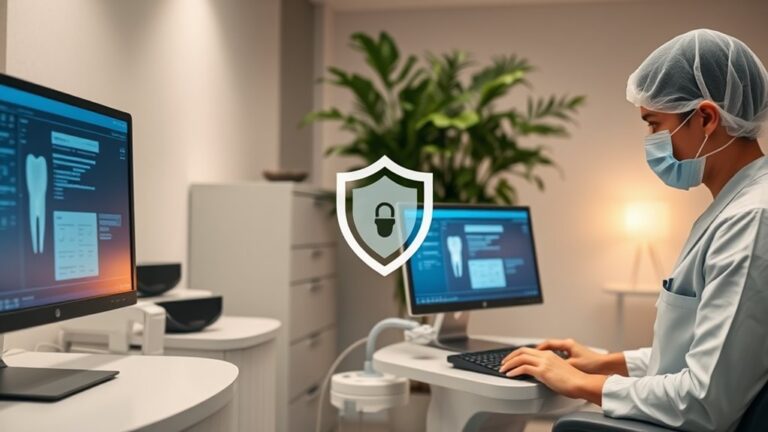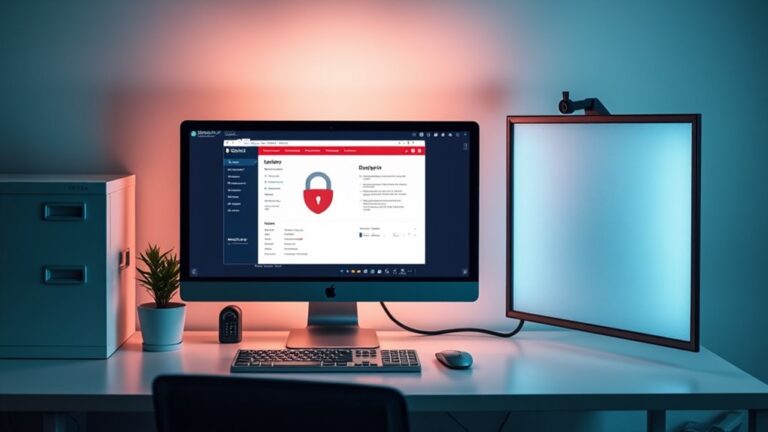10 Best HIPAA Security Protocols for Patient Management Systems
When managing patient information, safeguarding electronic protected health information (ePHI) is non-negotiable. Implementing the right HIPAA security protocols can greatly reduce your risk of data breaches and ensure compliance. From robust data encryption methods to effective access controls, there are clear strategies you can employ. But what about those often-overlooked aspects, like auditing and disaster recovery? Understanding these protocols is vital, and once you grasp their importance, you'll see how they can transform your patient management system. If you need assistance with these protocols, feel free to contact us. We can connect you with experts who can provide tailored solutions to help you stay compliant and secure. Let's explore what you need to prioritize to maintain the integrity of your patient management system.
Data Encryption
Implementing data encryption is essential for safeguarding electronic Protected Health Information (ePHI) in patient management systems. You must prioritize employing strong encryption algorithms like Advanced Encryption Standard (AES), which is highly recommended by NIST. With a minimum key size of 128 bits, AES-256 provides robust protection against brute-force attacks and secures both data at rest and in transit. Additionally, organizations must ensure that third-party partners comply with encryption and data protection standards to maintain comprehensive security.
When encrypting data at rest, consider file and folder encryption. This method protects sensitive information even if devices are compromised, guaranteeing confidentiality by requiring the correct password or key for access. Compliance with NIST Special Publication 800-111 is critical in this regard.
For data in transit, Transport Layer Security (TLS) is indispensable. By utilizing AES-256 along with additional security measures, TLS maintains confidentiality and integrity during data transmission. You should adhere to NIST Publications 800-52 and 800-77 to guarantee robust protection.
Lastly, effective key management is essential. Establishing secure procedures for storing and managing encryption keys will enhance your compliance efforts and overall security posture.
Access Controls
Access controls serve as a critical line of defense in protecting electronic Protected Health Information (ePHI) within patient management systems, guaranteeing that only authorized individuals can access sensitive data.
Effective user authentication is essential; unique login credentials must be established for each employee, prohibiting credential sharing to enhance security.
Implementing role assignment through role-based access control (RBAC) guarantees users access only the minimum necessary information required for their job functions, complying with HIPAA regulations. Additionally, this approach is an integral part of HIPAA Access Management, ensuring that sensitive data is only available to those who need it to perform their job functions.
Permission management should be dynamic, allowing for prompt amendments when individuals change roles, thereby avoiding privilege escalation risks.
Access policies must stipulate how access to ePHI is granted, monitored, and adjusted.
Regular access reviews and access monitoring practices help maintain compliance and identify potential security gaps.
User auditing tracks logon and logoff activity, fostering accountability.
Further, employing two-factor authentication (2FA) alongside robust credential management enhances security layers, guaranteeing that access is granted based on verified identities.
Auditing and Logging
Auditing and logging create a robust framework for monitoring user interactions within patient management systems, guaranteeing accountability and compliance with HIPAA regulations.
By implementing detailed logging practices, you can greatly enhance your organization's security posture and improve breach detection capabilities. Here are four essential components to focus on:
- User Activities: Track login attempts—both successful and unsuccessful—to identify potential unauthorized access.
- Data Modifications: Log all changes to databases containing protected health information (PHI), capturing additions, deletions, and modifications.
- User Permissions: Monitor any changes to user roles and permissions to guarantee only authorized personnel access sensitive data.
- System Access: Record user access to files and databases, giving you insight into who accessed what and when. Audit logs help organizations demonstrate compliance during regulatory audits and facilitate identification and response to potential security incidents.
To maintain compliance, guarantee secure storage and audit log retention for at least six years.
Regularly review these logs to identify anomalies and address risks. By embedding these practices, you'll create a culture of accountability and safeguard your patients' information, ultimately enhancing trust and service quality.
Physical Safeguards
Physical safeguards play an essential role in protecting electronic protected health information (ePHI) within patient management systems. To guarantee robust facility security, implementing locks, alarms, and access control systems like biometric recognition and key codes is fundamental. These measures restrict unauthorized access to areas housing ePHI and help maintain a secure workstation environment. Additionally, developing contingency operation plans assures access to facilities during emergencies, while video surveillance can monitor sensitive areas effectively.
It's also important to establish clear policies regarding workstation use and security. Assess the location of workstations—whether in public areas or high-traffic zones—and secure them against unauthorized access through password protection and encryption. Limiting workstation access to authorized personnel only will further enhance security. Regular audits and updates to workstation security protocols are also crucial for maintaining compliance with HIPAA Security Rule standards.
Moreover, device and media controls are essential. You should guarantee the proper disposal of any devices containing ePHI and utilize secure storage options like locked cabinets.
Regularly reviewing and updating your physical safeguard measures will align with evolving workflows and facility changes, guaranteeing compliance with HIPAA Security Rule standards. By focusing on these critical elements, you can effectively protect ePHI and serve your patients with utmost integrity.
Technical Safeguards
Technical safeguards are crucial for guaranteeing the security of electronic protected health information (ePHI) in patient management systems. These measures protect sensitive data and promote compliance with HIPAA regulations.
Here are four critical technical safeguards you should implement:
1. Access Controls: Establish policies that permit access solely to authorized individuals, implementing identity verification mechanisms like unique user IDs and biometric systems.
Don't forget to set up emergency access procedures for urgent situations.
2. Audit Controls: Implement robust mechanisms to monitor and log ePHI access.
Regular audits are essential for tracking user activity and identifying unauthorized access or anomalies.
3. Integrity Controls: Guarantee ePHI remains unaltered and intact.
Use digital signatures and conduct routine integrity checks to verify that no unauthorized changes have occurred.
4. Transmission Security: Safeguard ePHI during transmission by using encryption and secure protocols.
Employ authentication methods, such as two-factor authentication, to guarantee that only verified entities access the information.
Staff Training
Effective staff training is essential for ensuring that all employees understand their roles in safeguarding electronic protected health information (ePHI) under HIPAA regulations. To achieve training effectiveness, you should cover HIPAA basics, including patient privacy rights and the importance of safeguarding PHI.
An overview of the HIPAA privacy rule and security rule, focusing on administrative, physical, and technical safeguards, is paramount. Regular updates on HIPAA regulations are crucial to ensure that staff are aware of the latest compliance requirements.
Implementing role-specific training allows you to tailor materials to meet the unique needs of different job functions. By using practical examples and case studies relevant to each role, employees can better grasp how compliance principles apply to their daily tasks.
Incorporating interactive elements like quizzes and discussions enhances engagement and knowledge retention.
New team members must receive training promptly during onboarding, with annual refresher courses scheduled to keep everyone informed of regulatory changes.
Tracking employee progress is essential for monitoring compliance and identifying areas for improvement. Remember, thorough documentation of training completion is necessary to demonstrate compliance.
Compliance Audits
When it comes to ensuring compliance with HIPAA regulations, compliance audits play a critical role in evaluating how well covered entities and business associates safeguard electronic protected health information (ePHI).
These audits help identify areas for improvement and confirm adherence to compliance requirements. The audit process typically involves several key steps:
- Pre-Audit Preparation: Entities receive a screening questionnaire to gather essential information.
- Document Submission: Audited organizations must provide detailed records, policies, and procedures within 10 business days.
- Review of Safeguards: Audits assess administrative, physical, and technical safeguards related to ePHI.
- Final Reporting: After reviewing findings, the final audit report includes responses from the entity and highlights areas needing attention. Additionally, participation in audits can help organizations access significant savings on insurance premiums, which is a valuable incentive for compliance.
Disaster Recovery
In any healthcare organization, having a robust disaster recovery plan is essential for safeguarding electronic protected health information (ePHI) and ensuring continuity of care. You must assign specific disaster recovery roles within your team, designating individuals or management groups responsible for overseeing the plan's implementation and maintenance.
Establish clear escalation procedures and communication protocols to facilitate smooth response efforts during incidents.
Conducting thorough risk assessment strategies is vital to identify vulnerabilities and threats to your ePHI. Involve key stakeholders across departments to gain a holistic understanding of potential risks and perform a business impact analysis (BIA) to evaluate your organization's critical functions. This analysis helps prioritize essential assets for data recovery. Additionally, implementing a data backup plan ensures that ePHI is regularly saved and can be restored quickly after a disaster.
Develop detailed procedures tailored to various disaster scenarios, ensuring that employees understand their responsibilities during these events.
Regularly test and update your disaster recovery plan to reflect organizational changes and technological advancements. By training all staff on their roles in the disaster recovery process, you strengthen your organization's resilience and commitment to maintaining patient care continuity, even in the face of unexpected disruptions.
Backup Protocols
Implementing robust backup protocols is vital for protecting electronic protected health information (ePHI) in any healthcare organization. To guarantee data availability and facilitate efficient backup recovery, consider the following key practices:
- Daily or Real-Time Backups: Schedule incremental backups to capture changes frequently, minimizing data loss.
- Automated Backup Processes: Utilize automation to reduce human error and enhance reliability in your backup procedures.
- Redundant Copies: Store backups in multiple secure locations, such as off-site or HIPAA-compliant cloud services, to safeguard against data loss. This redundancy in backup solutions enhances data availability, ensuring that healthcare data remains accessible even during unforeseen circumstances.
- Regular Testing and Revision: Consistently test your backup systems and revise protocols to adapt to evolving compliance requirements.
Incorporating strong data encryption practices, both at rest and in transit, is essential. Confirm you use robust encryption standards, like 128-bit or 256-bit, and securely manage encryption keys.
Implement strict access controls and conduct regular audits to maintain compliance with HIPAA guidelines.
Risk Management
Effective risk management is vital for safeguarding protected health information (PHI) within healthcare organizations. To start, you need to conduct an extensive risk assessment that includes an inventory of all locations where PHI exists, both electronic and non-electronic. This inventory will help you identify vulnerabilities, such as those found in hardware, software, and data transmission.
Once you've identified these vulnerabilities, implement administrative, technical, and physical safeguards tailored to reduce risks to a reasonable level. Develop a robust risk management plan, assigning specific action steps to qualified personnel. It's important to coordinate these efforts with your IT department or consultants to guarantee a thorough approach. Additionally, ensure that your practices comply with HIPAA regulations, as this is essential for maintaining the confidentiality and integrity of patient data.
Don't forget to evaluate your risk analysis at least once a year, as ongoing vigilance is key. Regular employee training on security policies and the use of encryption for electronic PHI will further enhance your safeguards.
Frequently Asked Questions
What Are the Penalties for HIPAA Violations?
When you violate HIPAA, you face significant penalties, including fines ranging from $141 to over $2 million, depending on the violation's severity and duration. Understanding these violation consequences is essential for maintaining compliance and safeguarding patient trust.
How Often Should We Update Our Security Protocols?
While a security audit reveals vulnerabilities, a protocol review guarantees compliance. You should update your security protocols regularly, ideally annually or when significant changes occur, to protect sensitive information and serve your patients effectively.
What Constitutes Ephi Under HIPAA Regulations?
ePHI, or electronic protected health information, includes examples like medical records and billing data stored electronically. You must guarantee secure ePHI storage and protection to comply with HIPAA regulations and safeguard patient privacy.
Can Patients Access Their Own Ephi?
Yes, you have patient rights to access your ePHI. You can request copies through various methods, and covered entities must respond within specified timeframes, ensuring compliance with HIPAA regulations for your privacy and security.
How Can We Ensure Third-Party Vendors Comply With HIPAA?
Ensuring third-party vendors comply with HIPAA is like building a sturdy bridge—conduct thorough vendor assessments and compliance audits, guaranteeing they meet security standards, and maintain ongoing monitoring to protect sensitive patient information effectively.
Conclusion
In the realm of healthcare, where patient trust is paramount, implementing these HIPAA security protocols isn't just a best practice—it's a necessity. Think of it as building a fortress around your sensitive data, much like King Arthur's Camelot, where only the worthy can enter. By prioritizing encryption, access controls, and regular audits, you're safeguarding not just ePHI but also the very foundation of quality care.
If you're feeling overwhelmed by the complexities of these protocols, don't hesitate to reach out to us for assistance. Our expert help can save you time, reduce stress, and ultimately improve your dental practice. Embrace these measures with our guidance, and you'll ensure that your patient management system remains both secure and compliant, allowing you to focus on what truly matters—providing excellent care to your patients.





